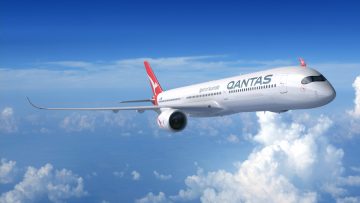
Qantas will boost its international network with extra flights, more aircraft and new routes as it restores capacity in line with strong travel demand and the broader recovery of the aviation industry.
From late October, the Australian national carrier will add around one million seats to its international network over 12 months compared to its current schedule, offering customers more choice to popular destinations across Asia, the United States and the Pacific.
The additional capacity will be made possible through a combination of more Qantas aircraft returning to service, new aircraft joining the fleet and an arrangement with oneworld partner Finnair to operate two Airbus A330-300 aircraft on two Qantas routes.
The network changes will see the group’s international capacity grow to around 100 per cent of pre-Covid levels by March 2024, up from 44 per cent 12 months ago and 84 per cent today.
Most of the flying announced today will be powered by the 2,400 pilots and cabin crew Qantas has recruited into the Group since borders reopened; a further 300 people will be needed by the end of the year.
Over the past six months, Qantas has brought five international aircraft back into its fleet – some from long term storage and some that were on standby as operational spares while the industry stabilised.
A new Boeing 787-9 Dreamliner arrived in May and another two will be delivered next month.
The latest Qantas A380 stored in the desert was reactivated in January and an additional A380 will return to service at the end of the year following maintenance and modifications to the cabin.
This announcement comes as Qantas prepares to resume San Francisco flights next week and launch its inaugural service from Sydney to New York via Auckland next month.
Seasonal services to Rome and flights between Melbourne and Hong Kong will resume in June.
Qantas will double its flights to Japan, increasing from 14 to 28 per week, offering the choice of four daily flights from November 26.
Sydney –Tokyo will increase from daily to double daily, Melbourne – Tokyo will increase from four per week to daily, and Brisbane – Tokyo will increase from three per week to daily. The services from Melbourne and Brisbane will move to Narita Airport.
Sydney – Shanghai flights will recommence for the first time in more than three years with daily A330 flights from October.
Sydney – Hong Kong capacity will be boosted by more than 50 per cent over the peak Australian summer season, with daily flights to be operated by a mix of A380 and A330 aircraft, while Melbourne – Hong Kong will increase from four per week to daily.
Melbourne – Singapore will increase from 10 to 14 per week, and Sydney – Singapore will be upgraded from 14 to 15 per week from 31 March 2024.
Melbourne – Delhi flights will increase from three to six per week over the peak Australian summer season.
“The rebound in demand for international travel since borders reopened has been incredibly strong and this boost to our network will add hundreds of thousands of seats in time for the busy Australian summer holiday period,” said Qantas CEO Alan Joyce.
“Qantas has been the most on-time major domestic airline for the past eight months in a row and that improved performance means we can release some of the aircraft we’ve had in reserve. That reflects more parts of the aviation supply chain returning to normal and it’s a huge credit to the hard work of our people across the Group.
“While airlines globally are working to restore capacity to meet demand, there is still a mismatch between supply and demand for international flying. But with more of our aircraft back in the air, new 787s joining our fleet and our contract with Finnair, we’ve got more seats for our customers and more opportunity for Qantas crew as we increase our own flying.
“We know our customers are looking for great value and this additional capacity will also put downward pressure on fares.”
The Finnair A330 aircraft will operate selected Qantas flights between Sydney and Singapore from late October and all flights between Sydney and Bangkok from late March 2024, freeing up Qantas aircraft and crew to boost flying elsewhere.
For the first two-and-a-half years of this agreement, flights will be operated by Finnair pilots and cabin crew, with customers continuing to receive Qantas’ inflight food and beverage service, amenities, inflight entertainment and baggage allowance.
From late 2025, two Finnair A330s will be dry leased, operating for up to three years with Qantas pilots and cabin crew, creating new jobs and further promotional opportunities within Qantas.











